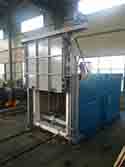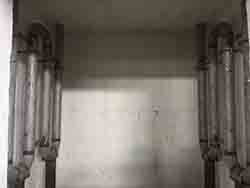In modern metal processing and heat treatment, annealing is a critical process for improving material properties, eliminating internal stresses, and enhancing ductility and toughness. Among these processes, the aluminum plate annealing furnace, as a core piece of equipment specifically designed for heat treating aluminum alloy sheets, is widely used in industries such as aerospace, automotive manufacturing, electronics, and architectural decoration. To ensure consistent quality, operational safety, and production efficiency, mastering a scientific and standardized operating procedure is essential. This article provides a detailed breakdown of the six key steps in operating an aluminum plate annealing furnace, from equipment inspection to unloading, helping operators improve efficiency and product quality.
Before starting the aluminum plate annealing furnace, a comprehensive equipment check and environmental preparation must be conducted—this is the foundation for ensuring smooth follow-up operations.
First, clean the workbench and the exterior of the furnace, removing oil, dust, and other debris to prevent contamination of the aluminum surface. Inspect the furnace door seals for integrity to ensure good airtightness of the chamber, preventing heat loss or outside air from entering and affecting the annealing atmosphere. For aluminum plate annealing furnaces using protective gases (such as nitrogen or argon), verify that gas lines are securely connected and leak-free, and check that pressure gauges and flow meters are functioning properly.
Next, inspect the heating elements (such as resistance wires, silicon carbide rods, or induction coils) for damage or aging. Check the temperature control system—including thermocouples, temperature controllers, and PLC systems—for accuracy and responsiveness to ensure temperature readings match setpoints. Additionally, test the ventilation and cooling systems to ensure uniform internal airflow and prevent localized overheating.
Finally, set the annealing parameters according to process requirements, including heating rate, holding temperature, holding time, and cooling method. For highly automated aluminum plate annealing furnaces, process curves can be programmed via touchscreen or computer interface for precise control.

Loading is a crucial step affecting annealing quality. When loading aluminum plates into the aluminum plate annealing furnace, follow these principles:
1. Arrange plates neatly: Aluminum sheets should be placed flat on furnace racks or trays, avoiding tilting or excessive stacking to prevent uneven heating or deformation.
2. Maintain proper spacing: Leave adequate space (typically 2–4 inches) between plates to allow for even heat circulation and uniform temperature distribution.
3. Avoid impact and scratches: Handle materials gently using specialized lifting tools or clamps to prevent surface scratches or dents that could affect appearance.
4. Control loading capacity: Do not overload the furnace. Batch sizes should be planned according to chamber volume and total aluminum weight to ensure efficient heat transfer.
For large-scale aluminum plate annealing furnaces, automated loading systems can be integrated to improve efficiency and reduce human error.
The heating phase is one of the most critical stages in aluminum plate annealing furnace operation. Aluminum alloys are sensitive to heating rates—too rapid heating can cause thermal stress, leading to warping or cracking, while too slow a rate reduces productivity.
Typically, the heating process consists of three stages:
- Preheating: Heat slowly (e.g., 100–200°F/h) to 400–600°F to remove moisture and oil from the aluminum surface.
- Rapid heating phase: Once above 600°F, increase the rate moderately (typically 300–400°F/h), staying within material limits.
- Slow approach to target temperature: Reduce heating speed as the set temperature is approached (e.g., 770–800°F, depending on alloy) to avoid overshooting.
For advanced applications, rapid thermal processing (RTP) furnaces can achieve heating rates up to 360°F per second, suitable for thin foils or precision electronic materials. These systems often use infrared or laser heating with closed-loop feedback for millisecond-level response.
Throughout the heating phase, operators must monitor temperature profiles in real time, ensuring temperature variation across zones remains within ±9°F for uniform microstructure.

Once the set temperature is reached, the soaking (holding) phase begins. The main goal is to equalize internal temperature throughout the plate and complete recrystallization, relieving work hardening and residual stresses.
Soaking duration depends on several factors:
- Plate thickness: Thicker plates require longer soaking to ensure the core reaches the target temperature.
- Alloy composition: Different aluminum alloys (e.g., 3003, 5052, 6061) have varying recrystallization temperatures and kinetics.
- Initial condition: Cold-rolled plates require longer soaking than hot-rolled ones.
Typically, soaking times in conventional aluminum plate annealing furnaces range from 1 to 4 hours. Metallurgical analysis or hardness testing can verify results, ensuring the material achieves desired mechanical properties and formability.
The cooling method directly affects the final microstructure and mechanical properties. Common cooling methods include:
1. Furnace cooling (slow cooling): Turn off the heater and allow the plate to cool naturally inside the furnace—ideal for full annealing to maximize ductility.
2. Forced air or gas cooling: Use fans or inert gas to accelerate cooling, suitable for partial annealing where some strength retention is desired.
3. Water quenching: Used only in special processes, such as solution heat treatment followed by rapid cooling to lock in the solid solution.
For aluminum plate annealing furnaces, a controlled cooling system is recommended, allowing adjustment of cooling rates to prevent deformation or residual stress from uneven cooling.
Only when the furnace temperature drops below 300°F should the door be opened to unload the plates. Removing hot plates risks oxidation and safety hazards.
After unloading, perform the following:
- Surface cleaning: Remove any light oxide film that may have formed.
- Quality inspection: Check flatness, hardness, and elongation to ensure compliance with standards.
- Categorization and storage: Sort by batch and specification to prevent mix-ups.
Additionally, regular maintenance of the aluminum plate annealing furnace—such as cleaning chamber residue, calibrating sensors, and replacing worn components—extends equipment life and ensures long-term reliability.
In summary, operating an aluminum plate annealing furnace is a systematic process involving equipment management, process control, and safety protocols. By strictly following the six-step procedure—equipment inspection → loading → heating → soaking → cooling → unloading—and adjusting parameters based on material characteristics and product requirements, operators can fully leverage the performance of the aluminum plate annealing furnace to produce high-quality, high-performance aluminum alloy sheets. As intelligent and automated technologies advance, aluminum plate annealing furnaces will continue evolving toward greater energy efficiency, precision, and environmental sustainability, providing strong support for high-end manufacturing.
BAI KA Copyright © 2025 ALL rights reserved